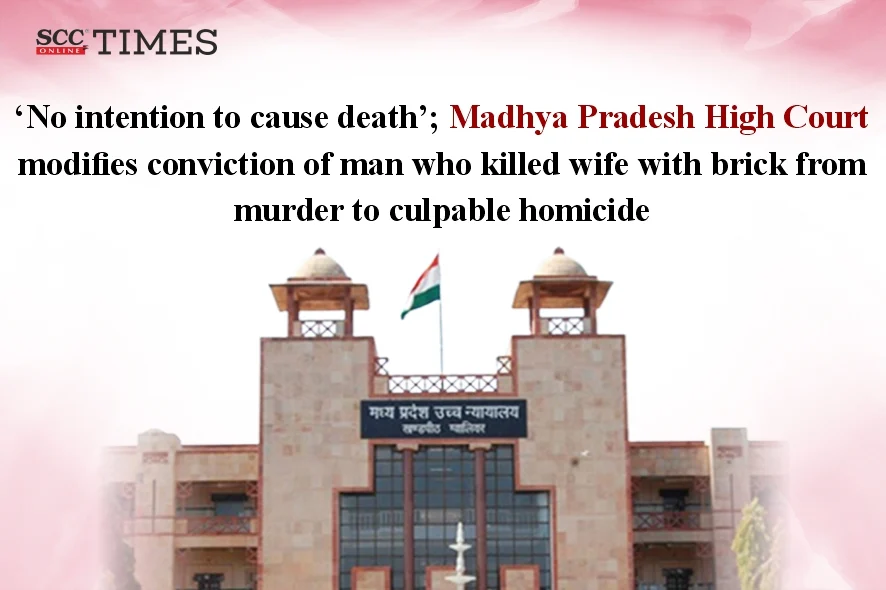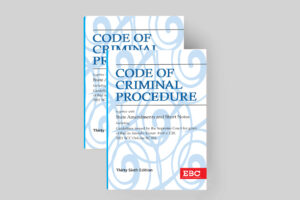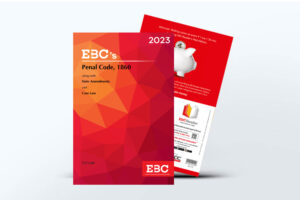Madhya Pradesh High Court: In a criminal appeal filed against the Trial Court’s order convicting and sentencing the convict to life imprisonment under Section 302 of the Penal Code, 1860 (‘IPC’) for killing his wife, the Division Bench of Vijay Kumar Shukla and Prem Narayan Singh*, JJ., modified the conviction from one under Section 302 to Section 304-II of the IPC since the convict acted in the spur of the moment.
Background
As per the prosecution’s story, on the day of the incident, the convict was demanding money from his wife, the deceased, but when she refused, he assaulted her with kicks and punches. When the complainant, the son, tried to intervene, the convict locked him away in a room. The convict’s uncle also tried to intervene, but the convict threw a brick at him. The next morning, when the complainant’s maternal aunt visited the house, and freed the complainant from his room. They proceeded to witness the deceased’s body lying on the floor.
Accordingly, the complainant filed an FIR against his father for the murder of his mother.
Analysis
The Court noted that the complainant had narrated the same story as the complaint in his statement under Section 164 of the Code of Criminal Procedure, 1973 (‘CrPC’), but later he became hostile, claiming that he did not know how his mother died. Similarly, the convict’s uncle too turned hostile, claiming that after being called by the complainant, he came, stopped the fight between the couple, and went to his home. However, he stated that he saw the convict holding a brick in one hand and the deceased’s hair in the other hand. Later, in his examination-in-chief, he stated that he did not know how the deceased died. Similarly, the complainant’s maternal aunt also turned hostile. Three other prosecution witnesses (‘PW’) did not support the prosecution’s case either.
Further, the Court noted that the doctor who performed the postmortem of the deceased stated that the reason for death was a head injury caused by a hard and blunt object. Noting this, the Court pointed out the correlation between the convict’s uncle seeing the convict with a brick and the reason for death being a head injury from a hard, blunt object.
The Court also pointed out that PW4’s statement that the complainant informed him that the convict had murdered the deceased, although PW4 had become hostile. The statement was relevant as it was an instant complaint.
Thus, the Court concluded that the death of the deceased occurred in the convict’s house, and it was the duty of the convict to explain it. In this regard, the Court referred to Bable v. State of Chhattisgarh (2012) 11 SCC 181, wherein it was held that if the writer of the FIR turned hostile and other evidence proved the case, the contents of the FIR cannot be discarded.
The Court further underscored that in this case, the last seen theory would apply. As per the records, the death occurred at night, and the convict was the only person who shared the room/house with the deceased, where the body was later found. The Court stated that the convict could not give any plausible explanation for the death of his wife. Though he stated that he was in the forest for cutting wood at the time of the incident and did not know who killed the deceased, this explanation was not sufficient to prove his innocence. Additionally, the brick was seized from the convict, and upon examination, it was revealed that the brick had traces of human blood. In this regard, the Court referred to John Pandian v. State (2010) 14 SCC 129, wherein it was held that the presence of human blood on the weapon is required to be clarified by the appellant and if the appellant is failed to do so, such failure would entail proving of the prosecution story.
The Court reiterated that, as per the convict’s uncle, the convict had a brick in his hand, and he was assaulting the deceased. This statement was not specifically challenged in cross-examination. Further, the convict also tried to assault his uncle by throwing a brick at him. This statement too was narrated in the statement under Section 164 CrPC by the convict’s uncle and the complainant. Additionally, the fatal head injury was caused by the brick.
Thus, the Court concurred with the Trial Court’s findings that the fatal head injury was caused by the brick used by the convict.
Regarding whether the convict was punishable under Section 302 or 304—II of the IPC, the Court noted that the incident was a sudden scuffle between the convict and the deceased, which happened at home, where, prima facie, there was no eyewitness. Hence, the Court stated that it had to decide based on the statements of the complainant and the convict’s uncle.
Upon perusal of their statements, the Court stated that the incident happened suddenly when the accused hit the deceased with a brick on her head. Thus, the accused certainly had the knowledge of causing the death, but not the intention. The Court further noted that none of the three children of the accused and deceased mentioned any predetermination or any such motive for the act.
Accordingly, the Court held that the offence committed by the convict shall fall under the ambit of Section 304-II of the IPC, i.e., culpable homicide not amounting to murder, and not Section 302. In this regard, the Court referred to similar cases such as, Hussainbhai Asgarali Lokhandwala v. State of Gujarat 2024 SCC OnLine SC 1975, Dattatraya v. State of Maharashtra 2012 SCC OnLine SC 1301, and K. Ravi Kumar v. State of Karnataka (2015) 2 SCC 638, wherein the Supreme Court converted the conviction from Section 302 to Section 304-II of the IPC
Noting the aforesaid proposition of lam the Court reiterated that culpable homicide is not amounting to murder if it is committed without any premeditation, in a spur of a moment, in a sudden fight, in heat of passion upon a frivolous matters, and without an offender having taken undue advantage or acted in a cruel, ghastly, or unusual manner.
While placing reliance on the decision in Hussainbhai (supra), and considering the single fatal injury, witness statements, medical evidence, and the incident taking place in the spur of the moment, the Court dissented against the Trial Court’s findings regarding the convict’s conviction under Section 302 of the IPC.
Accordingly, the Court modified the conviction from Section 302 to Section 304-II of the IPC and sentenced the convict to rigorous imprisonment for 7 years along with a Rs. 5000 fine. However, the Court affirmed the Trial Court’s decision regarding the disposal of the seized property.
[X v. State of Madhya Pradesh, 2025 SCC OnLine MP 4475, decided on 25-06-2025]
*Judgment authored by: Justice Prem Narayan Singh
Advocates who appeared in this case :
For the Appellant: Manohar Singh Chouhan
For the Respondent: Dy. Advocate General Shrey Raj Saxena and Government Advocate H.S. Rathore





